10/11/2011 – by Dr. Robbin Laird
During my current visit to Europe, I have had the chance to talk with French military decision makers about the Libyan operation. I have also talked with USMC officers involved in the operation. I will first look at the French experience, then at the USMC experience and then compare the two to understand some of the tactical commonalities and perhaps some insights in the way ahead in shaping capabilities for littoral operations.
The French Experience
A main point underscored by the French military was the impact of the political process on military planning. The French President clearly saw the need for the operation and had worked closely with the British Prime Minister to put in place a political process, which would facilitate a Libyan support operation for the rebels. But until the UN Mandate was obtained, now military action could be authorized. This meant that there was little or no planning for military operations with the result that, in the words of one French military officer, “we were forced to craft operations on the fly with little or no pre-planning or pre-coordination. We did some on our own but until the authorization for action was in place, we could not mobilize assets.”
An impact of the slow roll out was that French weapons will not fully available at the start of the operation. Another officer indicated “the elements of French weapons were in various depots. We had to bring those elements together and to assemble them at the initial operational air base.”
The French ran surveillance operations prior to the air operation, but several officers indicated that they were concerned with the quality of the intelligence they had to work with. As an officer commented: “I was reasonably confident with regard to what we knew about the state of Libyan operations, but would have liked greater certainty before launching my aircraft.”
A key aspect of the French operation was the use of virtually the full gamut of their air combat capability, AWACS, tankers, Mirages, Rafales, and various helos engaged in the operation. This represented a series commitment by the French leadership to the operation and to mission success.
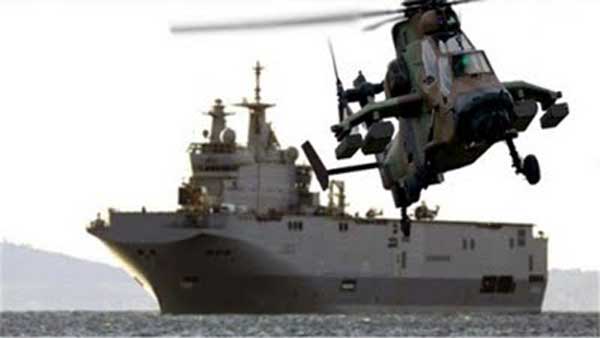 French Amphibious Ship and Helos Played a Key Role in the Operation (Credit: http://convenientflags.blogspot.com/2011/05/tonnere-helicopter-carrier-to-libya.html)
French Amphibious Ship and Helos Played a Key Role in the Operation (Credit: http://convenientflags.blogspot.com/2011/05/tonnere-helicopter-carrier-to-libya.html)
Clearly one key element which emerged from the operation was the strategic significance of multiple basing to conduct operations. The French used multiple bases to operate their air capability. They operated from bases inside France at the beginning of the operation. They then used bases in Corsica (Solenzara was a crucial air base for the operation) as well as in Italy, notably Sigonella (which is supposed to be closed this year). They used two key sea bases, the aircraft carrier (Charles De Gaulle) and their helicopter carrier (the Mistral) for combat strike, recce operations, helo operations as well as processing intelligence from joint French air assets and sending targeting information back up to the strike force. They used Souda in Greece to work with the Omanis who were using their Mirage 2000s for the first time in combat, and the French and Omanis worked together in using the French and Omani 2000s for strike operations.
There were a number of firsts for the French in the operation. This was the first large-scale operation by France working with NATO since rejoining NATO. This was the first use of the Tiger combat helicopter off of the Mistral. This was the first use of a new precision-guided weapon in operations to destroy Libyan armor and other ground equipment (the Air-to-Ground Modular Weapon). This was the first time the French flew in combat with an Arab partner using an advanced version of the Mirage 2000 for ground strike missions. This was the first use of the new reconnaissance pod on the Rafale, which played a major role in the operation.
The Mistral featured prominently in the operations as well. This helicopter carrier has proven to be a very versatile asset. It has a deck, which can support six helos operating in combat operations. It has hanger space for 16 helicopters. And the Tiger helicopter operated off of the Mistral in night operations. The helos operated in the words of one French officer as “vampires” able to operate at night to lower the capabilities of the Libyan forces.
An aspect of the operation of the helos off of the Mistral is noteworthy as well. The guns of the frigate with which it was deployed used its guns to support the helo deployment. The guns provided the fire suppression enhancing the security of the insertion of the helos off of the Mistral.
The C2 on the ship is first rate and was part of the link to the air fleet in receiving and processing information to shape an intelligence picture to support strike operations. What this demonstrated that integrating maritime with land-based air can provide a powerful littoral operations capability, one which may prove very relevant to the United States as it rethinks the relationship between the USAF and the USN-USMC team in shaping 21st century operations.
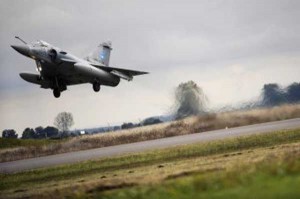
Two additional aspects of operations as they moved forward were highlighted from the French point of view. First, the limitations placed on the operation curtailed the ability to succeed and enhanced the ability of Ghadafi to survive. And second, after the initial air operations, dynamic targeting was a central objective, and various problems in executing such targeting became evident.
The limitations were three fold.
First, rules of engagement were being proposed by the partners of France in NATO that were “ridiculous” to quote one French officer. “We received from NATO sources the directive that there were to be NO civilian casualties from our air strikes. My view was “why not just not do airstrikes.” We pushed back and insisted on something sane: “No excessive civilian casualties from NATO air strikes.”
And the second limitation was allowing Gadaffi to operate in a sanctuary in Libya. As one officer put it: “We wanted to destroy an airfield being used by Gadaffi to bring in mercenaries. We should have destroyed this airfield.” Third, the American contribution was much more limited than it needed to be. Another officer added “We had 4-5 areas to cover for the air operation; the Americans provided only two UAVs – Predators—which operated for only part of the day. We need to augment our own capabilities to be sure, but……”
And finally the operation underscored the challenge of “dynamic targeting.” The shift from destroying identifiable military equipment being used by the Libyan forces supporting Gadaffi to engaging forces on the ground countering the rebels required “dynamic targeting.” And this can only be done by situational awareness which allows aircraft to target elements blended with the population and this requires aircraft flying low, with close proximity weapons, with forces on the ground able to identify targets in a fluid situation. As a French officer put it: “We had difficulty getting authorization to fly low, we had limited close proximity weapons and we had severe limitations of forces on the ground able to identify accurate targets.”
For one senior officer the problem was clear: “Going forward we have to augment our capability to do dynamic targeting. If we are going to intervene in situations where we are supporting contested space and need to support either local or our own forces, we need better capabilities to influence the situation on the ground. Air systems can clearly do this, but in coordination with ground targeting elements. And the pilots need to be granted more authority. We have to stop believing that some far away command authority has better SA or moral authority than the pilot over the target. And the notion that unmanned systems are going to replace the pilot is ludicrous in a dynamic targeting situation. We are reluctant to give a guy with SA in the pilot’s seat authority, why are we going to give some guy in Nevada or Paris looking through a soda straw the authority to do dynamic targeting.”
The USMC Experience
With the decision of the US national command authority to “lead from behind,” the USMC almost inadvertently was given a leading role. What “lead from behind” meant operationally was that the US was not going to commit significant combat air capabilities to the fight, so the F-22 returned from Middle East exercises to not be used in the battle and the Aircraft Carrier which was in the Mediterranean was sent to support US ground troops in Afghanistan. The US was to provide a C2 package to support the operation as well as ground attack capabilities such as A-10s and C-130 gun ships. And most importantly, the US provided tanking and related air support to the allied operations.
The point here is NOT that the US did not provide significant support to the operation, it is what happened which was really not expected. And what this really is all about is the performance of the USMC and the USN-USMC amphibious ready group team. What the ARG ended up doing was re-shaping the next phase of operational history. The recent Secretary of Defense confused amphibious with Inchon, whereas in reality the ARG is a seabase from which one can conduct a variety of operations across the spectrum of warfare.
And the ARG is in the throes of fundamental change, with new ships, and new planes providing new capabilities. And these new capabilities are nicely congruent with the operational experiences off of the Libyan coast. Given the USMC battle hymn, it seems that off the shores of Tripoli can have a whole new meaning for the evolution of the US force structure.
The ARG was used in several unprecedented ways in the Libyan operation.
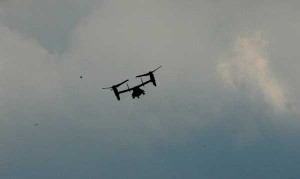
First, the Osprey was a key element of changing how the US forces operated. The Osprey provided a logistical lynchpin, which allowed the ARG to stay on station and to allow the Harriers to have greater sortie generation rates and ops tempo. The use of the Osprey in the operation underscored the game changing possibilities of the ARG in littoral operations of the future.
As Lt. Col. Boniface, the ACE commander of the 26th MEU (the force off of Libya) noted:
A complete transformation to how we are doing business has been involved. In order for the USS Kearsarge, the ARG and the 26th MEU to stay in their operational box during Operation ODESSEY DAWN, and enable the Harriers to continue their strike mission, we were reliant on other assets to supply us. For many supply items, the Osprey provided the logistical link to allow the ARG to stay on station and not have to move towards at sea re-supply points and meet re-supply ships.
Without the Osprey you would have to pull the USS Kearsarge out of its operational box and send it somewhere where it can get close enough to land or get close enough to resupply ships to actually do the replenishment at sea. Or you would be forced to remain where you are at and increase the time you’re going to wait for this part by three, four days or even a week.
The ARG ships are only moving at 14-15 knots. At best, let’s just say they move an average of 13 knots per hour, and add that up for the 300 miles that you have to sail. Now you’re looking at least a day to get the needed folks, parts or equipment and then the transit time back to the operational box. The V22 will do that in a couple hours and allow the ARG/MEU to keep executing its mission.
Second, the current operation of the ARG is to be disaggregated. For the MEU, the combat elements might be on the ship, might be ashore, or might be in transit. The challenge for the MEU commander is to be able to concentrate force upon the task at hand. Prior to the Libyan operations, Col. Dessens, the 26th MEU commander, faced the challenge of assembling his capability to fight the battle and then to be able to flexibly alter the force mix on the sea base. What this meant was that some of his Ospreys were in Afghanistan, and not on his ARG ships. And after the initial operations, the Marines assembled ground forces if they were to be needed. The key point here is that the sea base, which in effect the ARG is, can provide a very flexible strike package. And the ability of the ARG to operate off of the coast of Libya meant that the air element would be able to generate significant sortie rates.
The logistics of the situation made it clear that the maritime operational bases were clearly critical to the operations. The nearest non-naval attack aircraft are coming out of Aviano, Italy. That’s about 1,000 miles north of Benghazi. For a fixed wing guy, that’s at least one tank (aerial refueling) just to get to work, one tank to get back, and probably a tank in between. Whereas, with a big deck amphib in the Gulf of Sidra, the average commute was 100 miles.
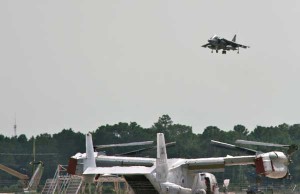
Third, given the close proximity, now the Harriers could operate with significant sortie rates against enemy forces. Not only could the Harriers come and go rapidly, but also the information, which they obtained with their litening pods, could then be delivered ABOARD the ship and processed and used to inform the next strike package out. One did not need a long C2 or C4ISR chain to inform combat. This meant as well that the ground forces of Gadaffi would not have moved far from what the last Harriers saw before the new Harriers moved into attack positions. The combination of compressed C4ISR and sortie rates created a deadly combination for enemy forces and underscored that using sea bases in a compressed strike package had clear advantages over land based aircraft several hours from the fight and managed by C4ISR operating over several hundreds and even thousands of miles.
As Col. Dessens further elaborates:
On the 19th, we get the first air strikes. As the ATO [Air Tasking Order] shook out, the Marines ended up being the last ones to fly that night. However, there’s a silver lining in every cloud. The litening pod, integrated on the AV-8B Harrier II, is one of the best things ever invented.
The beauty of us coming in towards the end of the night is we were able to go do a complete run with a litening pod up and down the roads south of Benghazi, record everything in that battlespace, and do all the processing in quick order aboard the Kearsarge. We shared everything we had with the JFACC (Joint Forces Air Component Commander) who didn’t have UAVs available until a few weeks later. We were able to do a complete analysis from the systems on the Harriers, turn it back around, and start getting ready for the next day.
This is where you start to see the advantages we had by being close to the target area, if I’m coming from Aviano, my data’s at least two and a half hours old. Things may well have moved. So now I have to reacquire to do the things I need to do. On the other hand, if you are only 100 miles away, the intelligence update you walked to the aircraft with is only fifteen minutes old as you enter the target area – and your target is right there waiting for you. We enjoyed a very high target to sortie rate because of tactical intelligence advantage.
Many further points could be made about the USMC operation but I will add a fourth and then move to the implications moving forward. The Osprey and the Harrier worked closely together to enhance combat capabilities. An aspect of this simply the ability of the Osprey to bring parts and support elements to the Harriers. Rather than waiting for ships to bring parts, or for much slower legacy rotorcraft, the Osprey at more than 300 miles an hour could bring parts from land bases to keep the ops temp up of the Harriers.
And the TRAP or rescue mission certainly highlighted how a vertically launched aircraft working with the Osprey off of the ARG can create new capabilities. From the time of authorization to the recovery of the pilot and his return to the USS Kearsarge was 43 minutes.
And how this happened also shows significant developments. The US Air Force had a rescue helo aboard the USS Ponce, but it was not used for this operation. In my view, having discussed this with the relevant personnel, it was not used for two reasons. It would have gotten to the pilot much later than an Osprey team and secondly the command and control would have been much slower than what the USMC could deliver. The key to the USMC C2 was that the pilots of the Ospreys and Harriers planned the operation together in the ready room of the USS Kearsarge. They did not meet in virtual space. The Harriers were informed by fresh intelligence ABOARD the USS Kearsarge. The sea base brought together the assets and intelligence to execute the mission.
One of the Osprey pilots highlighted the synergy between his plane and that of the Harrier.
We immediately started talking to the Harrier operating above us. And he starts talking with the pilot and we can hear one side of the conversation and I can tell that things are getting worse on the ground.
We made the judgment that we had to accelerate the mission. We moved towards our top speed as the pilot was moving to a new location on the ground.
The pilot on the ground indicated that “they’re still going at us, and things are getting worse.” And he is clearly on the move.
We had the grid of the plane crash site and we got a new grid and realized that it was much further away from where the original crash site was. So he’d been on the move the whole time.
If I had been flying a SEA KNIGHT, by the time I had gotten the new information with regard to the shift in the grid, and flown for the 40 minutes under those conditions, I would have been relatively exhausted by the time I got there because you’re holding the controls, and you’re getting shaken the whole time.
Convergences and the Way Ahead in Littoral Operations
By an almost accidental set of events, the French operational experience dovetailed with that of the USMC and suggested a way forward, certainly for US thinking about littoral operations.
If we look at the congruence of the French with the USMC experience several things can be highlighted.
First, the centrality of leveraging multiple bases in a littoral operation is significant. The French used several land bases and incorporated the sea base –whether the carrier of their amphibious ships – to work with land based aircraft. The USMC used their land base largely to supply the sea based air ops via Osprey transport.
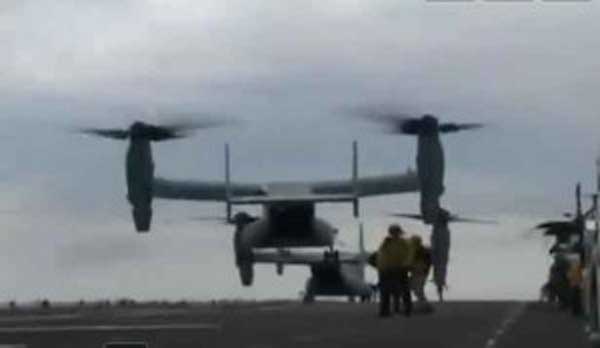 The Osprey Landing on the French Warship Tonnere (Credit: French Navy, https://sldinfo.com/us-marines-aboard-the-french-warship-fns-tonnerre/)
The Osprey Landing on the French Warship Tonnere (Credit: French Navy, https://sldinfo.com/us-marines-aboard-the-french-warship-fns-tonnerre/)
Second, having the C4ISR forward deployed with the pilot as the key decision maker is crucial to mission success. The classic USAF CAOC system is challenged by what the USMC demonstrated in the operation; the French experience also challenges it. In a recent piece on AOL Defense, the point was made that some French pilots felt that the release authority from Predator information was too slow. The interpretation was unhappiness with the US but I would argue that is more in the nature of the problem than the nationality in charge. If you have a long C4ISR chain, the information in a fluid and dynamic situation must be provided in a more timely fashion than a system built for 1991 air operations permits.
Third, new air capabilities make a significant difference. For the USMC, the Osprey was the game changer in this operation. For the French, it was the new recce pods off of the Rafales.
Fourth, the dynamic targeting problem discussed in the first article was also highlighted by the USMC experience. Getting accurate information from the ground is central to operations. The USN-USMC team has a number of new capabilities being deployed or acquired which will enhance their ability to do such operations. The F-35B will give the USMC an integrated electronic warfare and C4ISR capability. The new LPDs have significant command and control capabilities. The new LCS could provide along with the Osprey significant combat insertion capability for ground forces and rapid withdrawal capability. For the French, acquiring UAVs, which could become wingmen for the Rafaels would be important and the role of the C2 capabilities of the new amphibious ships were underscored as well.
Fifth, the pick up quality of this operation may be more a norm than an aberration moving forward. If it is the old paradigm of significant planning and roll out of a fleet of C4ISR aircraft and capabilities may be challenged by a new one. Deploying air assets that can be tapped by the sea base to shape an operation may become one of the key requirements moving forward.
As with any operation, the characteristics are unique and not determinate for the future. The limited capabilities of the Libyan forces are important in assessing lessons learned. But what the USMC and the French forces have demonstrated is that 2011 is not Iraq 1991 or Bosnia 1996.
For an earlier posting of this argument see
http://defense.aol.com/2011/10/06/marine-libya-lessons-short-command-control-links-stovl-flexibi/
http://defense.aol.com/2011/09/23/french-libya-lessons-learned-better-targeting-flexible-roes-l/

